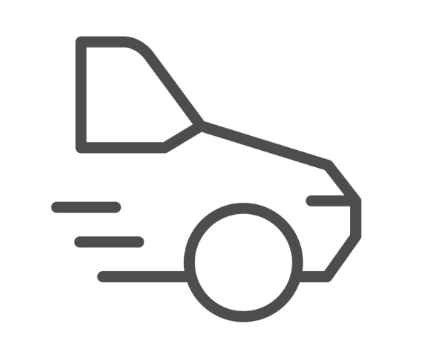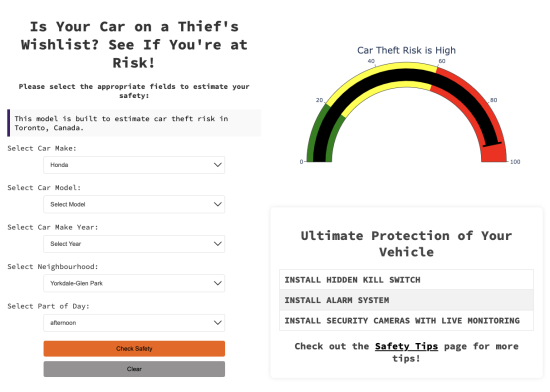Vehicle Safety Analyzer
Empowering Toronto drivers by educating them about car theft and providing effective strategies to minimize that risk.
Problem & Motivation
Did you know that a simple trip to a mall can cost you a car? Car theft in Canada, particularly in Toronto and the surrounding area, has become a significant issue, with a car stolen every five minutes and a 300% increase in thefts since 2015. In fact, hot spots for car thieves include open air parking lots and popular shopping malls, such as Yorkdale Shopping Centre, Fairview Mall and Scarborough Town Centre. The emotional and financial toll on victims is significant, causing disruption in daily life and a sense of insecurity. Sophisticated theft methods, such as electronic key fob hacking and cyber-attacks, compound the problem, making it difficult for vehicle owners to feel safe.
Our Solution
Our product, the Vehicle Safety Analyzer, aims to prevent such incidents by providing real-time data on high-risk areas and practical security tips. By analyzing historical theft data and leveraging advanced analytics, our tool offers personalized recommendations to enhance vehicle security and inform the user. This proactive approach helps drivers make informed decisions about where to park and how to protect their vehicles, ultimately contributing to a safer community.
Data Source & Data Science Approach
Our product is built by leveraging Auto Theft Open Data from Toronto Police Police Service Public Safety Data portal, vehicle population data from Ontario Data Catalogue and Theft of Motor Vehicle Open Data from Ottawa Police Community Safety Data Portal. We created synthesized dataset due to data limitations in the original dataset. Specifically, the dataset of stolen cars was missing key features of stolen vehicles, such as MAKE, MODEL and MODEL-YEAR of the car. We supplemented this dataset by randomly assigning these features from the Ottawa stolen cars dataset. Additionally, we worked with unbalanced dataset and we used resampling under-sampling technique in order to create a balanced dataset of stolen and non stolen vehicles.
We used Optuna to identify the most important features. We selected XBoost model as our final ML Model because it provided the best performance and accuracy.
Evaluation
Generated risk score category was compared to expected risk category of car theft based on our research. In that evaluation, we also considered publications of insurance companies, local newspaper articles, polica statements and user stories.
Key Learnings & Impact
We faced challenges with identifying complete dataset that contains stolen and registered vehicles for Toronto, Canada. Our key learning from this project is how to come up with a synthetic dataset and build valuable insights to fulfill our mission of empowering Toronto drivers by educating them about car theft and providing effective strategies to minimize that risk. As a result, we hope our personalized recommendations not only reduce the risk of car theft but also significantly improve community safety.
Acknowledgements
We would like to thank our Capstone Instructors, Fred Nugen and Danielle Cummings for their actionable and thoughtful feedback throughout the process. We are grateful for everyone who tested our product and provided feedback to make it better.














